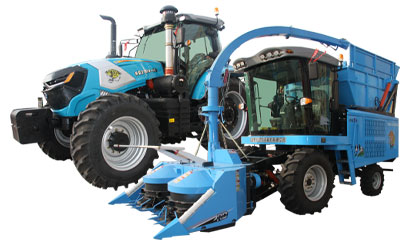How does the Runda Silage Machine harvest corn in rainy days? Suggestions from experts at Shandong Provincial Animal Husbandry Station
Since September this year, there have been multiple rounds of rainfall in our province, with some areas receiving over 50% more rainfall than the same period in the year, causing the soil to be too wet and some fields to accumulate water; Silage harvesting machinery is unable to operate on the ground, and in some areas, corn has lodging. All these have seriously affected the normal harvesting progress and quality of silage.
How to reduce the impact of continuous rainfall on mechanized harvesting of silage corn and maximize the production and supply of silage?
Shandong Runda Agriculture and Animal Husbandry Technology Co., Ltd. is a professional developer of silage harvesting machinery. Zhai Guiyu, a researcher at the Shandong Provincial Livestock Husbandry Station and an expert in the forage modulation and processing position of the forage industry system in Shandong Province, proposed several technical opinions and suggestions.
Reasonable selection of suitable silage machinery
When facing land with accumulated water or high soil moisture, it is advisable to use tracked silage harvesting machinery to prevent vehicle sinking; When facing flooded or waterlogged corn, it is advisable to choose a high-performance silage corn harvester with adjustable stubble height; When facing corn with severe lodging and a high rate of plant breakage, it is advisable to choose a silage corn harvester with a ground roller cutting table.
In addition, light and flexible vehicles with relatively low self weight, relatively small load capacity, and difficulty in sinking are selected for field transportation. The harvested and stored corn is transported to a hard and solid surface on the ground, and then transported by heavy-duty vehicles to the silage cellar.
Correct operation of silage machinery
When the silage harvesting machinery is operating, an appropriate operating speed should be selected based on the flooding situation of the plot to improve operating efficiency and quality. If the efficiency of the silage harvester operation is high and the transportation vehicles are not followed up in a timely manner, it will affect the productivity of the operation. Therefore, it is necessary to ensure that the transportation vehicles are in place in a timely manner.
During homework, the stubble height can be adjusted appropriately, and regular inspections can be conducted to adjust it in a timely manner; At the same time, regularly check the cutting length of silage corn and adjust the operating speed in a timely manner. Minimize the entry of waterlogged leaves and stems into silage materials as much as possible.
During homework, it is necessary to try to prevent the occurrence of chain detachment and related component blockage caused by ear or straw jamming in the crop chain. Pay attention to observing components that are prone to blockage and entanglement, such as the agitator, elevator, and straw chopping device. If blockage occurs, stop the machine and clean it to ensure the normal operation of all working components.
Maintenance and debugging of silage machinery
Before operating the silage harvesting machinery, carefully inspect the operation of the walking system, steering system, and lifting system of the harvesting machinery from a local to an overall perspective to ensure good trial operation; To check the cutting table, conveying, kneading, unloading and other mechanisms of the harvesting machinery for any abnormal noise, deformation of components, etc., and promptly solve any problems found.
According to the growth status and water accumulation degree of different plots of corn, adjust the header height, feeding system, crushing system and other devices of the harvesting machinery before entering the land to improve the smoothness of harvesting and feeding of silage corn and prevent blockage. Adjust the number and sharpness of the cutting blades of the harvesting machinery, improve the chopping degree and operation speed, and increase the reliability of the operation.
Prepare spare parts in advance and respond promptly to potential machine malfunctions.
Finally, Zhai Guiyu reminded that attention should be paid to the safety of harvesting machinery operations.
There are many types of vehicles that need to be used and allocated during the harvesting process of silage. Regardless of the operating link or type of machinery, it is necessary to always maintain safety production awareness. All parts and components with safety hazards must have safety warning signs set up in obvious positions to prevent accidental operation from causing casualties.
(Chen Jianzhi, Rural Journalist, Popular Newspaper Industry)
[Source: Shandong Provincial Bureau of Animal Husbandry and Veterinary Medicine Livestock News]

 NewsPower machinery covers three major series:walking tractor, middle and high-horsepower wheel tractors. The product power covers from 6hp to 260hp, and produces more than 60 models
NewsPower machinery covers three major series:walking tractor, middle and high-horsepower wheel tractors. The product power covers from 6hp to 260hp, and produces more than 60 models ProductsGetting machinery focuses on the independentresearch and development and production of green (yellow) storage of feed and har vesting machinery.
ProductsGetting machinery focuses on the independentresearch and development and production of green (yellow) storage of feed and har vesting machinery. VideoThe company adheres to the business philosophy of "reliable products and customer satisfaction", always adheres to innovation driven and high-quality development
VideoThe company adheres to the business philosophy of "reliable products and customer satisfaction", always adheres to innovation driven and high-quality development




